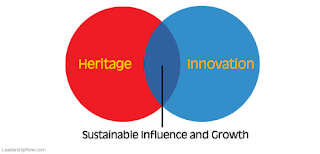In times of change there is the tendency to either stick doggedly to what has always worked in the past or to throw it all out and start new. Neither extreme is the answer.
Heritage and innovation is a tension that needs to be managed—thoughtfully. Our default thinking is to view the world in terms of what has worked before so we often fail to address the changes going on around us. As a result we tend to lose our influence. At the same time, to overhaul everything without regard to our roots—our traditions, our heritage—can take us away from why we began doing what we are doing in the first place.
Howard Schultz recognized as he began to deal with Starbuck’s identity crisis in 2008 that they had to strike a delicate balance between heritage and innovation. In Onward he writes: “I understood that we had to return to our roots, but if that heritage was not linked to a willingness to reinvent and innovate, then we would fail.”
Our heritage is the repository of our values and unshakable truths. Applying them to a changing world makes them relevant. But how to go about this is not always self-evident. As we naturally view what we do through the lens of what has worked before, it is hard to envision a different world. If we don’t learn to apply them to what is happening today, they begin to look worn and outdated to the present world.
We have to begin by asking, “What is Truth (for us) and what is habit?” Truths are maintained. Habits can be adapted.
We need to learn to translate our heritage into a meaningful direction aligned to the present situation. Heritage either stands the test of time or it is a fad. Change for change sake, is faddish. Sustainable influence and growth is achieved when heritage and innovation overlap. Innovation should be informed by heritage which is in turn, made relevant by it.
Change is essential to growth. More than anything else, fear keeps us from making necessary changes. Fear of the unknown. “What will happen?”
Innovation rocks the boat. It creates instability, yes, but the kind of instability needed for growth. If we don’t make heritage relevant by innovation we can stunt growth and diminish our influence. We actually aid people’s ability to cope and thrive in a changing world when we find ways to change what we do without changing who we are. Heritage and innovation is an ongoing tension that needs to be managed.
[from Leading Blog: A Leadership Blog @ LeadershipNow

No comments:
Post a Comment